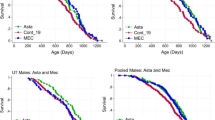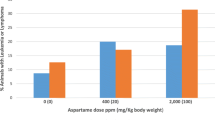Abstract
Studies were conducted to determine the comparative effects of tocopherols and tocotrienols on normal mammary epithelial cell growth and viability. Cells isolated from midpregnant BALB/c mice were grown within collagen gels and maintained on serum-free media. Treatment with 0–120 μM α-and γ-tocopherol had no effect, whereas 12.5–100 m μM tocotrienol-rich fraction of palm oil (TRF), 100–120 μM δ-tocopherol, 50–60 μM α-tocotrienol, and 8–14 μM γ- or δ-tocotrienol significantly inhibited cell growth in a dose-responsive manner. In acute studies, 24-h exposure to 0–250 μM α-, γ-, and δ-tocopherol had no effect, whereas similar treatment with 100–250 μM TRF, 140–250 μM α-, 25–100 μM γ- or δ-tocotrienol significantly reduced cell viability. Growth-inhibitory doses of TRF, δ-tocopherol, and a-, γ-, and δ-tocotrienol were shown to induce apoptosis in these cells, as indicated by DNA fragmentation. Results also showed that mammary epithelial cells more easily or preferentially took up tocotrienols as compared to tocopherols, suggesting that at least part of the reason tocotrienols display greater biopotency than tocopherols is because of greater cellular accumulation. In summary, these findings suggest that the highly biopotent γ- and δ-tocotrienol isoforms may play a physiological role in modulating normal mammary gland growth, function, and remodeling.
Similar content being viewed by others
Abbreviations
- BSA:
-
bovine serum albumin
- DMEM:
-
Dulbecco's modified Eagle's medium
- EGF:
-
epidermal growth factor
- HPLC:
-
high-performance liquid chromatography
- IC50 :
-
treatment dose that induces 50% growth inhibition
- LD50 :
-
treatment dose that induces 50% cell death
- MTT:
-
3-(4,5-dimethylthiazol-2yl)-2,5-diphenyl tetrazolium bromide
- α-T:
-
α-tocopherol
- γ-T:
-
γ-tocopherol
- δ-T:
-
δ-tocopherol
- α-T:
-
α-tocotrienol
- γ-T3 :
-
γ-tocotrienol
- δ-T3 :
-
δ-tocotrienol
- TGF:
-
transforming growth factor
- TRF:
-
tocotrienol-rich fraction
References
Packer, L. (1991) Protective Role of Vitamin E in Biological Systems,Am. J. Clin. Nutr. 53, 1050S-1055S.
Elson, C.E. (1992) Tropical Oils: Nutritional and Scientific Issues,Crit. Rev. Food Sci. Nutr. 31, 79–102.
Kimmick, G.G., Bell, R.A., and Bostick, R.M. (1997) Vitamin E and Breast Cancer: A Review,Nutr. Cancer 27, 109–117.
Chatelain, E., Boscoboinik, D.O., Bartoli, G.-M., Kagan, V.E., Gey, F.K., Packer, L., and Azzi, A. (1993) Inhibition of Smooth Muscle Cell Proliferation and Protein Kinase C Activity by Tocopherols and Tocotrienols,Biochim. Biophys. Acta 1176, 83–89.
Stauble, B., Boscoboinik, D., Tasinato, A., and Azzi, A. (1994) Modulation of Activator Protein-1 (AP-1) Transcription Factor and Protein Kinase C by Hydrogen Peroxide andd-α-Tocopherol in Vascular Smooth Muscle Cells,Eur. J. Biochem. 226, 393–402.
Turley, J.M., Ruscetti, F.W., Kim, S.J., Fu, T., Gou, F.V., and Birchenall-Roberts, M.C. (1997) Vitamin E Succinate Inhibits Proliferation of BT-20 Human Breast Cancer Cells: Increased Binding of Cyclin A Negatively Regulates E2F Transactivation Activity,Cancer Res. 57, 2668–2675.
Fazzio, A., Marilley, D., and Azzi, A. (1997) The Effect of α-Tocopherol and β-Tocopherol on Proliferation, Protein Kinase C Activity and Gene Expression in Different Cell Lines,Biochem. Mol. Biol. Int. 41, 93–101.
Turley, J.M., Fu, T., Ruscetti, F.W., Mikovits, J.A., Bertolette, D.C., III, and Birchenall-Roberts, M.C. (1997) Vitamin E Succinate Induces Fas-mediated Apoptosisin Estrogen Receptornegative Human Breast Cancer Cells,Cancer Res. 57, 881–890.
Zhao, B., Yu, W., Qian, M., Simmons-Menchaca, M., Brown, P., Birrer, M.J., Sanders, B.G., and Kline, K. (1997) Involvement of Activator Protein-1 (AP-1) in Induction of Apoptosis by Vitamin E Succinate in Human Breast Cancer Cells,Mol. Carcinog. 19, 180–190.
Yu, W., Sanders, B.G., and Kline, K. (1997)RRR-α-Tocopheryl Succinate Inhibits E14 Thymic Lymphoma Cell Growth by Inducing Apoptosis and DNA Synthesis Arrest,Nutr. Cancer 27, 92–101.
Sigounas, G., Anagnostou, A., and Steiner, M. (1997)DL-α-Tocopherol Induces Apoptosis in Erythroleukemia, Prostate, and Breast Cancer Cells,Nutr. Cancer 28, 30–35.
Yu, W., Israel, K., Liao, Q.Y., Aldaz, C.M., Sanders, B.G., and Kline, K. (1999) Vitamin E Succinate (VES) Induces Fas Sensitivity in Human Breast Cancer Cells: Role forM r 43,000 Fas in VES-Triggered Apoptosis,Cancer Res. 59, 953–961.
Cottrell, R.C. (1991) Introduction: Nutritional Aspects of Palm Oil,Am. J. Clin. Nutr. 53, 989S-1009S.
Sundram, K., Khor, H.T., Ong, A.S.H., and Pathmanathan, R. (1989) Effects of Dietary Palm Oils on Mammary Carcinogenesis in Female Rats Induced by 7,12-Dimethylbenz(a)anthracene,Cancer Res. 49, 1447–1451.
Sylvester, P.W., Russell, M., Ip, M.M., and Ip, C. (1986) Comparative Effects of Different Animal and Vegetable Fats Fed Before and During Carcinogen Administration on Mammary Tumorigenesis, Sexual Maturation, and Endocrine Function in Rats,Cancer Res. 46, 757–762.
Gould, M.N., Haag, J.D., Kennan, W.S., Tanner, M.A., and Elson, C.E. (1991) A Comparison of Tocopherol and Tocotrienol for the Chemoprevention of Chemically Induced Rat Mammary Tumors,Am. J. Clin. Nutr. 53, 1068S-1070S.
Nesaretnam, K., Khor, H.T., Ganeson, J., Chong, Y.H., Sundram, K., and Gapor, A. (1992). The Effect of Vitamin E Tocotrienols from Palm Oil on Chemically Induced Mammary Carcinogenesis in Female Rats,Nutr. Res. 12, 879–892.
Zurinah, W., Ngah, W., Jarien, Z., San, M.M., Marzuki, A., Top, G.D., Shamaan, N.A., and Kadir, K.A. (1991) Effect of Tocotrienols on Hepatocarcinogenesis Induced by 2-Acetylaminofluorene in Rats,Am. J. Clin. Nutr. 53, 1076S-1081S.
Goh, S.H., Hew, N.F., Norhanom, A.W., and Yadav, M. (1994) Inhibition of Tumour Promotion by Various Palm-Oil Tocotrienols,Int. J. Cancer 57, 529–531.
Nesaretnam, K., Guthrie, N., Chambers, A.F., and Carroll, K.K. (1995) Effect of Tocotrienols on the Growth of a Human Breast Cancer Cell Line in Culture,Lipids 30, 1139–1143.
He, L., Mo, H., Hadisusilo, S., Qureshi, A.A., and Elson, C.E. (1997) Isoprenoids Suppress the Growth of Murine B16 Melanomasin vitro andin vivo, J. Nutr. 127, 668–674.
Guthrie, N., Gapor, A., Chambers, A.F., and Carroll K.K. (1997) Inhibition of Proliferation of Estrogen Receptor-Negative MDA-MB-435 and-Positive MCF-7 Human Breast Cancer Cells by Palm Oil Tocotrienols and Tamoxifen, Alone and in Combination,J. Nutr. 127, 544S-548S.
Nesaretnam, K., Stephen, R., Dils, R., and Darbre, P. (1998) Tocotrienols Inhibit the Growth of Human Breast Cancer Cells Irrespective of Estrogen Receptor Status,Lipids 33, 461–469.
Sylvester, P.W., Birkenfeld, H.P., Hosick, H.L., and Briski, K.P. (1994) Fatty Acid Modulation of Epidermal Growth Factor-Induced Mouse Mammary Epithelial Cell Proliferationin vitro, Exp. Cell Res. 214, 145–153.
McIntyre, B.S., Birkenfeld, H.P., and Sylvester, P.W. (1995) Relationship Between Epidermal Growth Factor Receptor Levels, Autophosphorylation and Mitogenic-Responsiveness in Normal Mouse Mammary Epithelial Cellsin vitro, Cell Prolif. 28, 45–56.
McIntyre, B.S., and Sylvester, P.W. (1998) Genistein and Erbstatin Inhibition of Normal Mammary Epithelial Cell Proliferation Is Associated with EGF-Receptor Down-regulation,Cell Prolif. 31, 35–46.
McIntyre, B.S., Briski, K.P., Hosick, H.L., and Sylvester, P.W. (1998) Effects of Protein Tyrosine Phosphatase Inhibitors on EGF- and Insulin-Dependent Mammary Epithelial Cell Growth,Proc. Exp. Biol. Med. 217, 180–187.
Imagawa, W., Bandyopadhyay, G.K., and Nandi, S. (1990) Regulation of Mammary Epithelial Cell Growth in Mice and Rats,Endocr. Rev. 11, 494–523.
Jones, W., Challowes, R.C., Choongkittaworn, N., Hosick, H.L., and Dils, R. (1983) Isolation of the Epithelial Subcomponents of the Mouse Mammary Gland for Tissue-Level Culture Studies,J. Tissue Cult. Methods 8, 17–25.
Tepper, C.G., and Studzinski, G.P. (1992) Teniposide Induces Nuclear But Not Mitochondrial DNA Degradation,Cancer Res. 52, 3384–3390.
Tsangaris, G.T., Moschovi, M., Mikraki, V., Vrachnou, E., and Tzortzatou-Stathopoulou, F. (1996) Study of Apoptosis in Peripheral Blood of Patients with Acute Lymphoblastic Leukemia During Induction Therapy,Anticancer Res. 16, 3133–3140.
Fariss, M.W., Pascoe, G.A., and Reed, D.J. (1985) Vitamin E Reversal of the Effect of Extracellular Calcium on Chemically Induced Toxicity in Hepatocytes,Science 227, 751–754.
Tirmenstein, M.A., Watson, B.W., Haar, N.C., and Fariss, M.W. (1998) Sensitive Method for Measuring Tissue α-Tocopherol and α-Tocopheryloxybutyric Acid by High-Performance Liquid Chromatography with Fluorometric Detection,J. Chromatogr. B. Biomed. Sci. Appl. 707, 308–311.
Schwartz, J., and Shklar, G. (1992) The Selective Cytotoxic Effects of Carotenoids and Alpha-Tocopherol on Human Cancer Cell Linesin vitro, J. Oral Maxillofac. Surg. 50, 367–373.
Birkenfeld, H.P., McIntyre, B.S., Briski, K.P., and Sylvester, P.W. (1996) Role of Protein Kinase C in Modulating Epidermal Growth Factor- and Phorbol Ester-Induced Mammary Epithelial Cell Growthin vitro, Exp. Cell Res., 223, 183–191.
Birkenfeld, H.P., McIntyre, B.S., Briski, K.P., and Sylvester, P.W. (1996) Protein Kinase C Isoenzyme Expression in Normal Mammary Epithelial Cells Grown in Primary Culture,Proc. Exp. Biol. Med. 213, 65–70.
Bandyopadhyay, G.K., Hwang, S., Imagawa, W., and Nandi, S. (1993) Role of Polyunsaturated Fatty Acids as Signal Transducers: Amplification of Signals from Growth Factor Receptors by Fatty Acids in Mammary Epithelial Cells,Prostaglandins Leukotrienes Essent. Fatty Acids 48, 71–78.
Bandyopadhyay, G.K., Imagawa, W., and Nandi, S. (1995) Role of GTP-Binding Proteins in the Polyunsaturated Fatty Acid Stimulated Proliferation of Mouse Mammary Epithelial Cells,Prostaglandins Leukotrienes Essent. Fatty Acids 52, 151–158.
Torelli, S., Masoudi, F., and Prasad, K.N. (1988) Effect of α-Tocopherol Succinate on Cyclic AMP-Dependent Protein Kinase Activity in Murine B-16 Melanoma Cells in Culture,Cancer Lett. 39, 129–136.
Ottino, P., and Duncan, J.R. (1997) Prostaglandin Levels in BL6 Melanoma Cells Culturedin vitro: The Effect of Vitamin E Succinate Supplementation,Prostaglandins Leukotrienes Essent. Fatty Acids 56, 143–149.
Hockenbery, D.M., Nunez, G., Milliman, C., Schreiber, R.D., and Korsmeyer, S.J. (1990) BcL-2 Is an Inner Mitochondrial Membrane Protein That Blocks Programmed Cell Death,Nature 348, 334–336.
Oltvai, Z.N., and Korsmeyer, S.J. (1994) Checkpoints of Dueling Dimers Foil Death Wishes,Cell 79, 189–192.
Nass, S.J., Li, M., Amundadottir, L.T., Furth, P.A., and Dickson, R.B. (1996) Role for Bcl-xL in Regulation of Apoptosis by EGF and TGFβ1 in c-myc Overexpressing Mammary Epithelial Cells,Biochem. Biophys. Res. Comm. 227, 248–256.
Heermeier, K., Benedict, M., Li, M., Furth, P., Nunez, G., and Hennighausen, L. (1996) Bas and Bcl-xs Are Induced at the Onset of Apoptosis in Involuting Mammary Epithelial Cells,Mech. Dev. 56, 197–207.
Fariss, M.W., Fortuna, M.B., Everett, C.K., Smith, J.D., Trent, D.F., and Djuric, Z. (1994) The Selective Antiproliferative Effects of α-Tocopheryl Hemisuccinate and Cholesteryl Hemisuccinate on Murine Leukemia Cells Result from the Action of the Intact Compounds,Cancer Res. 54, 3346–3351.
Hosomi, A., Arita, M., Sato, Y., Kiyose, C., Ueda, T., Igarashi, O., Arai, H., and Inoue, D. (1997) Affinity for α-Tocopherol Transfer Protein as a Determinant of the Biological Activities of Vitamin E Analogs,FEBS Lett. 409, 105–108.
Author information
Authors and Affiliations
Corresponding author
About this article
Cite this article
McIntyre, B.S., Briski, K.P., Tirmenstein, M.A. et al. Antiproliferative and apoptotic effects of tocopherols and tocotrienols on normal mouse mammary epithelial cells. Lipids 35, 171–180 (2000). https://doi.org/10.1007/BF02664767
Received:
Revised:
Accepted:
Issue Date:
DOI: https://doi.org/10.1007/BF02664767




